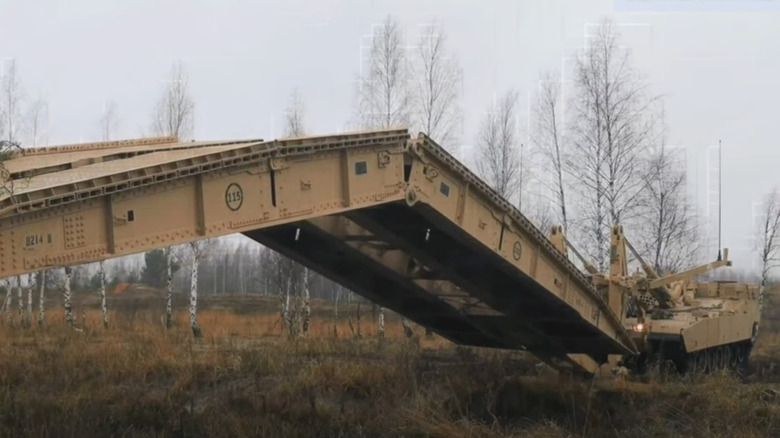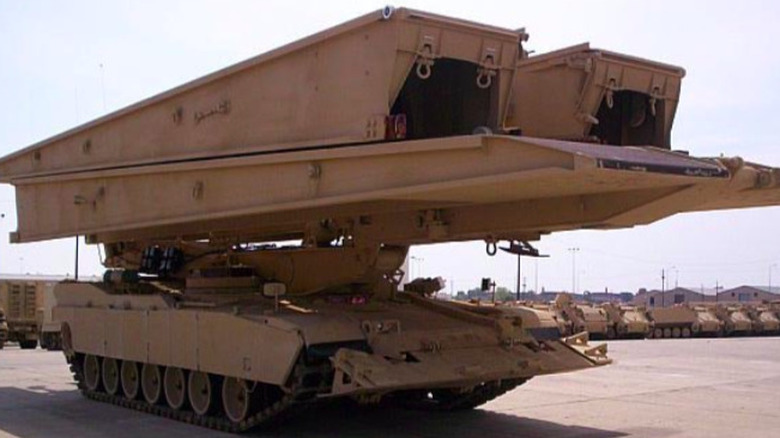What Is The Army's M104 Wolverine Bridgelayer, And Is It Still Being Used Today?
Natural features such as rivers, streams, and ravines have always proved troublesome to people moving from point A to point B. This is historically complicated when in a war setting. Not only do you have to contend with Mother Nature, but the adversarial action as well. The U.S. took its first steps to address such obstacles on June 16, 1775, when the Continental Congress appointed its first chief engineer, Col. Richard Gridley.
The Army Corps of Engineers, since its inception in 1794, has played a vital role in filling the Army's construction needs especially in time of conflict. Its expertise in fortification construction, pontoon and railroad bridges, and siege warfare proved invaluable. Iconic battles such as Bunker Hill and Yorktown in the American Revolution, the siege of Veracruz during the Mexican-American War, the crossing of the Rappahannock River during the Battle of Fredericksburg in the Civil War (and the first contested river crossing in American military history) all demonstrated the ingenuity and skill of the Corps. The American Expeditionary Force (AEF) of WWI had its engineers heavily involved in railroad, bridge, and labor construction to keep men and supplies flowing to and from the front lines.
Engineers in WWII saw their skills tapped in constructing domestic bases that housed 4.37 million soldiers while also deploying to the front lines to affix floating and fixed bridges and to destroy others during the Battle of the Bulge. However, the evolving nature of combat post-WWII warranted a change in how the U.S. constructed bridges in theater.
How they did it past to present
No longer beholden to felling thousands of trees for constructing bridges to cross an obstacle, the Army deployed a modified M60 Patton tank in the 1960s to do the job. A product of the Cold War, the M60 Armored Vehicle Landing Bridge (AVLB), combined the chassis of the M60 with that of a vehicle launched bridge system. The armored M60AVLB (up to 109mm in the hull front) has a top speed of up to 48 km/h and upon reaching its destination, can then deploy a 19m scissor bridge as fast as three minutes. The bridge can support vehicles of up to 54 tons, and, when done, can be retrieved in a minimum of 10 minutes.
The M60 AVLB has been a mainstay for both the Army and the Marines ever since, as well as seeing sustained service in other countries. Its inability to keep up with the speed of the M1 Abrams tank on the field (up to 70 km/h) as well as its deployed bridge not being able to support the weight of an Abrams tank, led the Army to begin development of its replacement in 1983. This saw General Dynamics Land Systems win a contract in 1994 to develop a new bridgelayer. It would take until 2003 when the first production model arrived: the M104 Wolverine Heavy Assault Bridgelayer.
Building bridges is the big time
The M104 Wolverine is built around a M1A2 System Enhancement Package (SEP) tank, giving it similar armor protection. It is manned by a crew of two, which utilizes a digital battlefield management system to assist with command and control. Unlike its predecessor, the M104 has the horsepower needed to keep up with modern tanks, reaching a top speed of 72 km/h, while also enjoying most of the benefits of its host platform such as armor and mobility. The Wolverine can deploy its nearly 11-ton heavy bridge in up to five minutes and recover it within 10.
The actual bridge is stacked in two sections above the hull. Upon arrival to the desired locale, the Wolverine anchors itself then joins the two bridge pieces together. The bridge, 26 meters long, is then extended over the terrain. The heavy bridge of the Wolverine can endure up to 5,000 crossing from vehicles of up to 70 tons and traveling up to 16 km/h. The Wolverine was intended to replace the aging M60 one-for-one, but costs and Army force realignments have led to only 44 vehicles being assigned to a few engineer units. A bigger, more robust bridge is exactly what the Wolverine brings to the table and in under five minutes. Though few in number with its successor already built — the M1074 American 10x10 Joint Assault Bridge System (JABS) that was introduced in 2016 — the M104 Wolverine Heavy Assault Bridgelayer still gives U.S. forces the upper hand in battlefield mobility.

